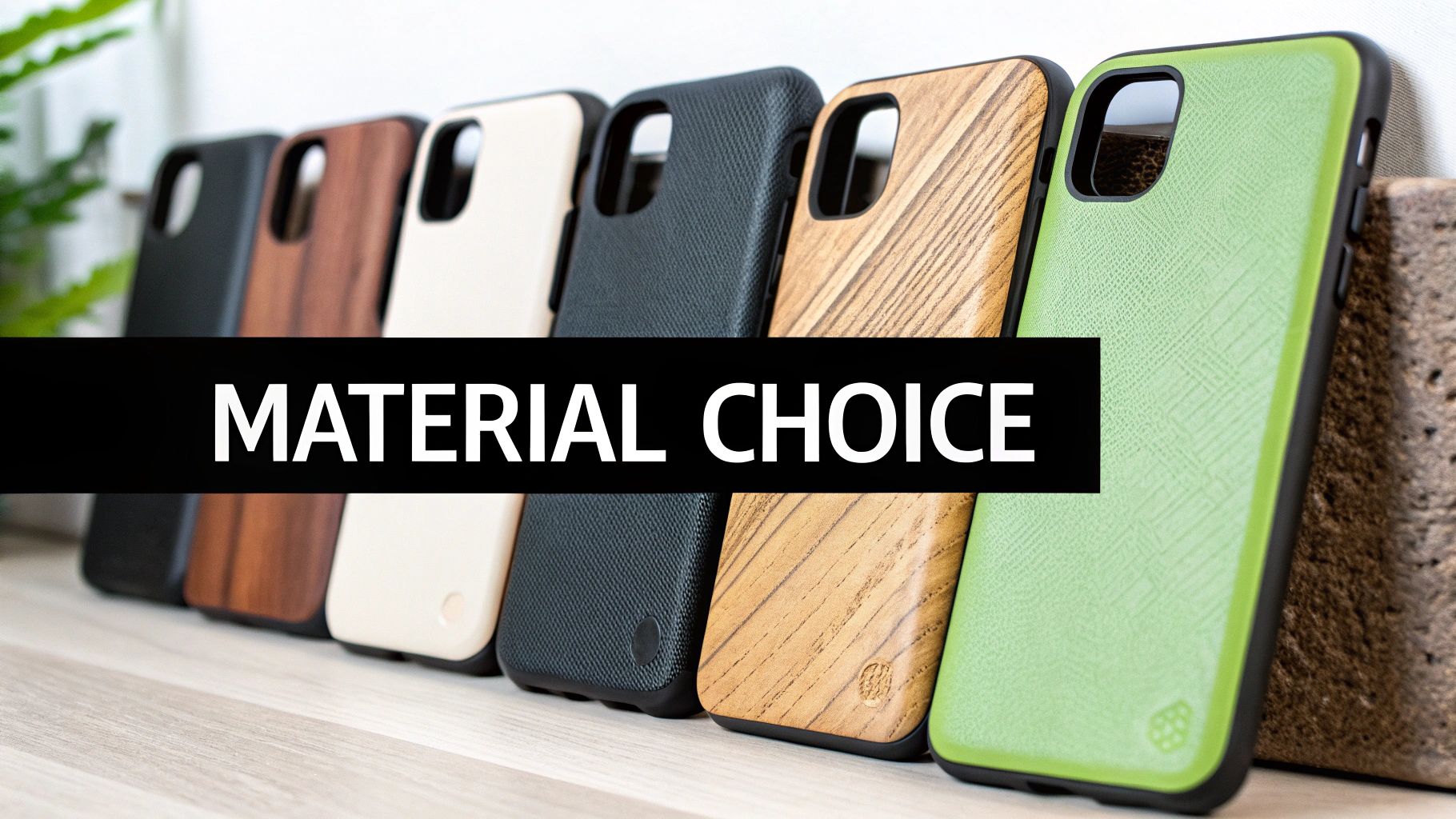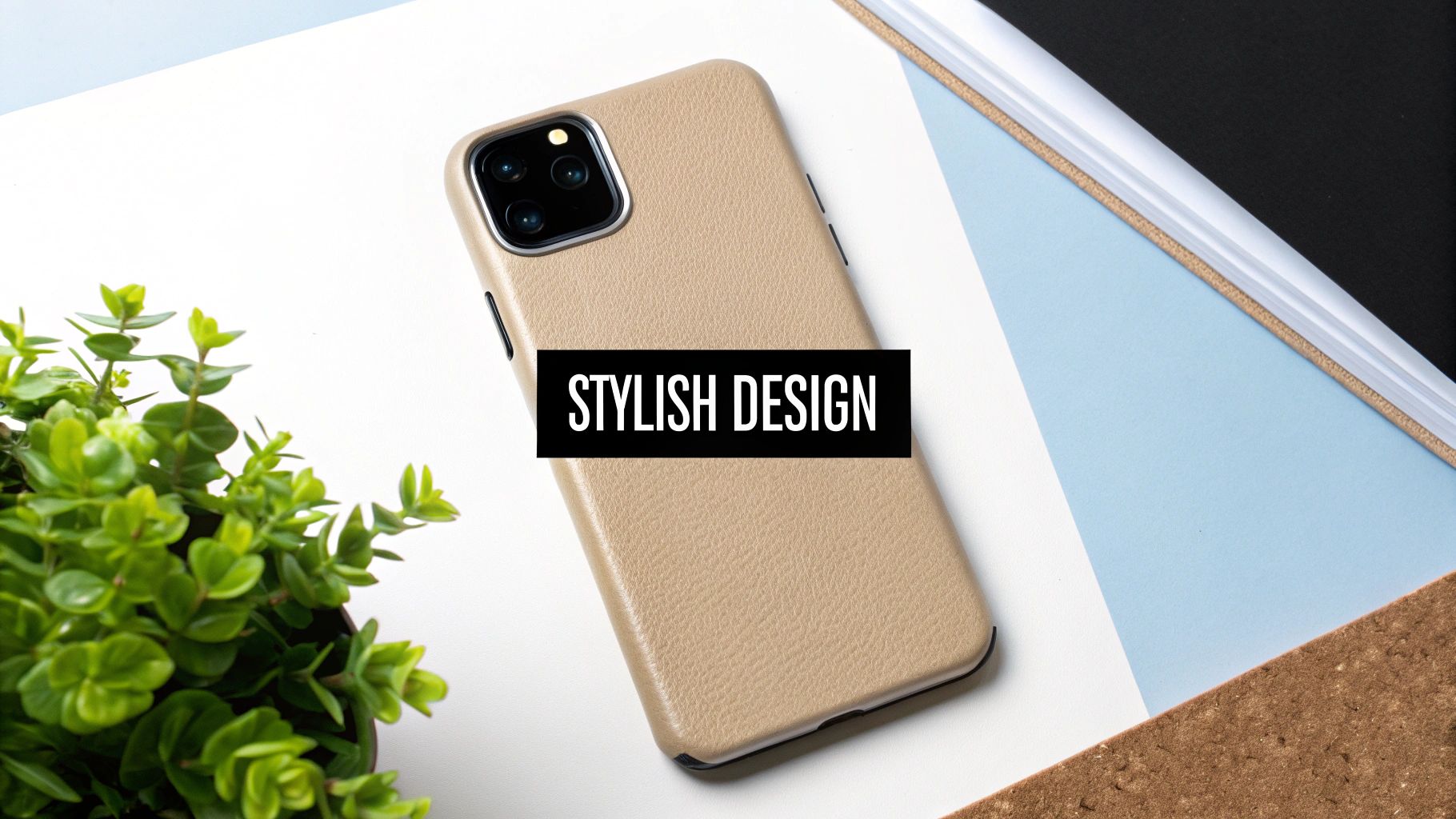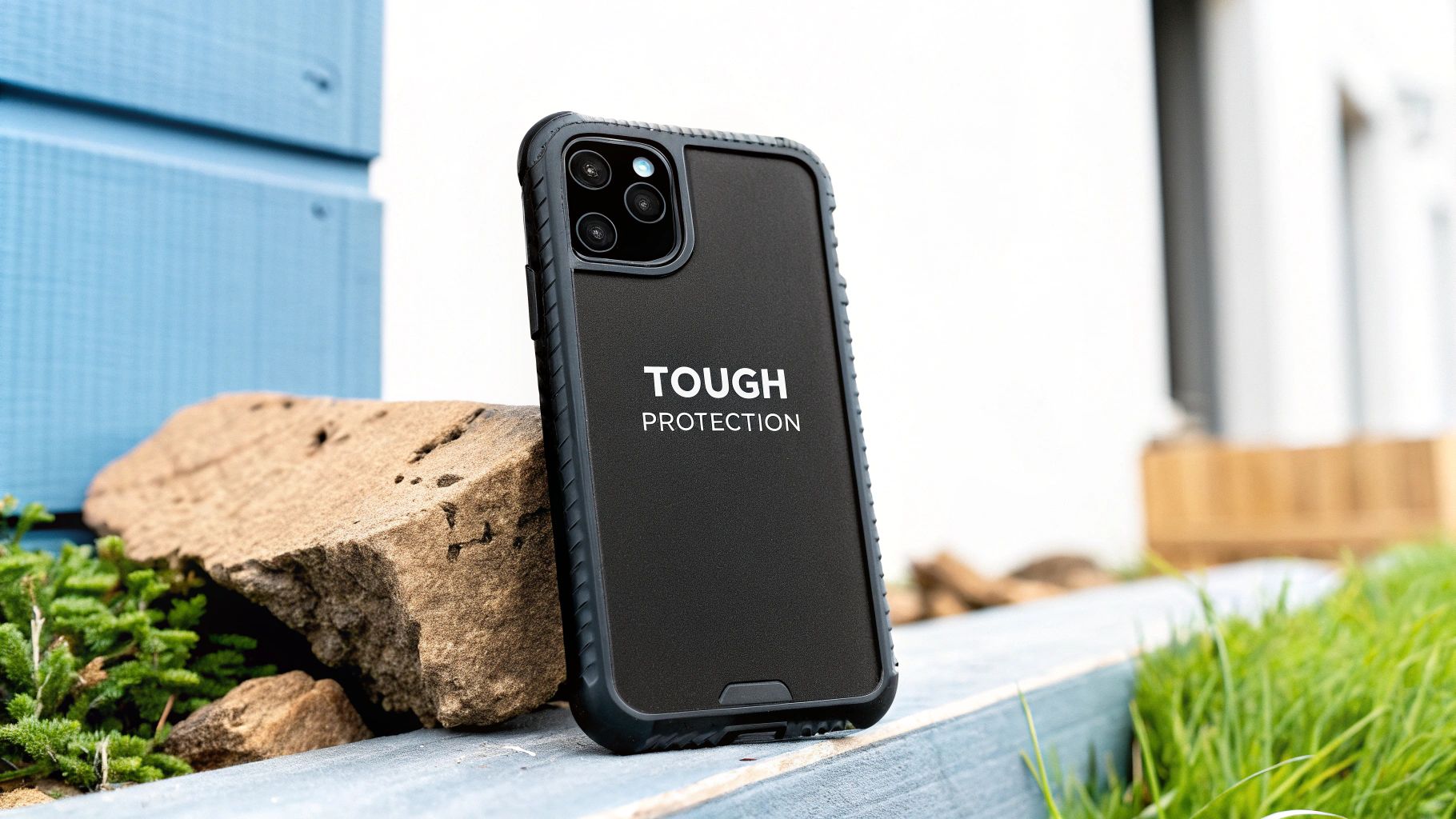Assessing Your Protection Priorities
Choosing the perfect phone case isn't one-size-fits-all. Your lifestyle heavily influences the protection your phone needs. A weekend hiker, for example, needs more durability than a fashion-forward professional. Understanding your individual needs is the first step. Honestly evaluate how often you drop your phone, its exposure to the elements, and your daily handling. Do you constantly juggle your phone with keys? Do you work outdoors in harsh weather? These questions will help determine essential protection features.
Identifying Your Risk Factors
Consider how often you've dropped your phone. If you're prone to drops, a rugged case with shock absorption is a must. Think about your typical environment. Outdoor enthusiasts need protection against dust, dirt, and water. For those in demanding environments, like construction sites, a military-grade case might be necessary. Think about your daily routine and potential hazards.
Protection Levels and Features
Different cases offer varying protection levels. Basic cases offer minimal protection against scratches and minor bumps. Mid-range cases usually have reinforced corners and raised edges for better drop protection. For maximum protection, heavy-duty cases withstand significant impacts and extreme conditions. Choose a protection level matching your needs for optimal defense without unnecessary bulk. Raised bezels around the screen and camera lens offer extra protection.
Matching Lifestyle to Case Type
The global phone case market is projected to reach tens of billions of dollars by 2033, driven by growing demand for phone protection. (Find more detailed statistics here) This growth underscores the importance of choosing wisely. For active individuals, a sporty case with a secure grip is ideal. Professionals might prefer a slim, stylish case. If you frequently use contactless payments, a wallet case with card slots is convenient. Your phone case should seamlessly integrate into your life, offering necessary protection without compromising usability or style.
To help you choose the best case, we've compiled a comparison table outlining key features to consider based on your lifestyle.
This table, "Phone Case Selection Criteria By User Type", helps readers identify which case features matter most based on their lifestyle and usage patterns.
|
User Type |
Primary Concerns |
Recommended Protection Level |
Key Features to Look For |
|---|---|---|---|
|
Active Individual |
Drops, Scratches, Dust/Dirt |
Medium to High |
Shock Absorption, Rugged Design, Secure Grip |
|
Professional |
Scratches, Minor Drops |
Medium |
Slim Design, Stylish Appearance, Wireless Charging Compatibility |
|
Outdoor Enthusiast |
Drops, Water/Dust Exposure, Extreme Temperatures |
High |
Waterproofing, Drop Resistance, Rugged Build |
|
Frequent Traveler |
Scratches, Minor Drops, Card Storage |
Medium |
Slim Design, Wallet Functionality, RFID Blocking (Optional) |
As you can see, different user types prioritize different features. Active individuals and outdoor enthusiasts require higher protection levels, while professionals and travelers may prioritize slim design and added functionality.

Decoding Case Types: Finding Your Perfect Match

Choosing the right phone case can be daunting. With so many options available, how do you know which one is best for you? This section breaks down the key differences between popular case types, helping you navigate the selection process. We'll explore the pros and cons of each, giving you a clear understanding of what to expect.
Slim Cases: Minimalist Protection
Slim cases offer a sleek, minimalist look and feel. They provide basic protection against scratches and minor bumps, with a slight lip to protect the screen. However, slim cases offer limited shock absorption. They are best suited for those who prioritize style and pocketability over heavy-duty protection.
Rugged Cases: Maximum Defense
If you need maximum protection, a rugged case is the way to go. These cases are designed to withstand significant impacts, featuring multiple layers of shock-absorbing material and reinforced corners. The trade-off for this increased protection is added bulk.
Wallet Cases: Convenience and Style
Wallet cases combine practicality and protection. They typically include card slots and a folding cover that can double as a stand. This allows you to carry your essentials in one place. While offering decent protection, wallet cases tend to be bulkier than slim cases.
Clear Cases: Showcasing Your Phone
Want to show off your phone's design? Clear cases offer scratch and minor drop protection while allowing your phone's aesthetics to shine through. Keep in mind that these cases offer less shock absorption than rugged cases and may yellow over time.
Battery Cases: Extended Power On-the-Go
Need a power boost? Battery cases integrate a built-in battery to extend your phone's battery life. The downside? They add significant bulk and weight. This added heft might make them less practical for everyday use.
Waterproof Cases: Protection From the Elements
Waterproof cases are designed for those who frequently encounter water or harsh weather conditions. They provide a complete seal against water and dust. Be aware that these cases may slightly muffle sound and impact touch sensitivity.
Choosing the Right Case for You
To help you select the perfect case, we've compiled a comparison table highlighting the key features and benefits of each type. This table provides a quick overview of protection levels, bulkiness, special features, and typical price ranges, enabling you to make an informed decision.
Comprehensive Phone Case Type Comparison:
|
Case Type |
Protection Level |
Thickness/Bulk |
Special Features |
Typical Price Range |
Best For |
|---|---|---|---|---|---|
|
Slim Case |
Low |
Thin |
Minimalist design |
Low to Medium |
Style-conscious users |
|
Rugged Case |
High |
Thick |
Shock absorption, reinforced corners |
Medium to High |
Active individuals, demanding environments |
|
Wallet Case |
Medium |
Medium to Thick |
Card slots, stand function |
Medium to High |
Convenience seekers |
|
Clear Case |
Low to Medium |
Thin |
Showcases phone design |
Low to Medium |
Design enthusiasts |
|
Battery Case |
Medium |
Thick |
Extended battery life |
Medium to High |
Power users |
|
Waterproof Case |
High |
Thick |
Water and dust protection |
Medium to High |
Outdoor enthusiasts |
The table above provides a detailed comparison of various phone case types, considering factors like protection level and price. By considering your lifestyle, daily activities, and desired level of protection, you can choose the perfect case to meet your individual needs. For further research, you might be interested in exploring additional resources. The next section will delve into the materials used in phone cases, providing even more insights to help you make the best choice.
Material Matters: Choosing Case Composition Wisely

Beyond simply selecting a case type, the materials used significantly impact its protective qualities, feel, and longevity. Choosing wisely means understanding the pros and cons of different compositions. This section explores popular materials like silicone, polycarbonate, and TPU, along with niche options like leather, metal, and wood, to help you find the perfect phone case.
Common Case Materials: A Detailed Look
-
Silicone: Silicone cases are known for their flexibility and soft, grippy texture. This makes them great for shock absorption and drop protection. However, silicone can attract lint and dust. Some silicone cases may also stretch over time, losing their snug fit.
-
Polycarbonate (PC): Polycarbonate is a hard, rigid plastic that offers excellent protection against scratches and impacts. PC cases are often slim and lightweight. The downside? Polycarbonate can be brittle and crack under pressure. While protective against scratches, they might not handle serious drops well.
-
Thermoplastic Polyurethane (TPU): TPU is a flexible plastic that combines desirable characteristics. It offers decent shock absorption like silicone and the durability and scratch resistance of polycarbonate. TPU is also more resistant to oils and grease than silicone. However, it might not be as grippy.
-
Leather: Leather cases offer a premium look and feel, developing a unique patina over time. They provide a good grip and some protection against bumps and scratches. Leather is more expensive and susceptible to scratches and wear. It's not ideal for wet or humid environments.
-
Metal: Metal cases are durable and stylish, but they can add weight and interfere with signal reception. Metal might scratch your phone's finish if the case isn't lined properly. Careful selection is crucial when considering a metal case.
-
Wood: Wood cases offer a unique, natural aesthetic. They can provide some protection against minor bumps and scratches. Wood is less durable than other materials and can crack or splinter.
The Rise of Hybrid Cases and Sustainable Materials
Combining materials often yields superior protection. Hybrid cases, often blending TPU and polycarbonate, are gaining popularity. These cases combine the impact-absorbing flexibility of TPU with the rigid support of polycarbonate, offering robust protection while remaining slim.
Sustainability is also influencing case materials. Brands are increasingly incorporating recycled plastics and bio-based materials into their cases. Choosing a sustainable case helps reduce your environmental impact.
Tactile Feel and Aging: The Long-Term Perspective
Your phone case’s material affects how it feels. Some prefer the soft grip of silicone, while others like the smooth, hard surface of polycarbonate. Choose a material you enjoy touching. Consider how the material ages, too. Leather develops a patina, while clear TPU or silicone can yellow or discolor. A long-term perspective is crucial when selecting a phone case that remains satisfying over time. Understanding material properties is essential for choosing a case that becomes a trusted companion, not a disappointment.
Beyond Basics: Protection Features That Actually Work

Not all phone cases offer the same level of protection. While many advertise appealing features, understanding which ones genuinely safeguard your device is crucial. This section explores the protective elements that truly matter when selecting a phone case, going beyond marketing jargon to focus on practical benefits. Key features include raised edges, reinforced corners, and shock-absorbing technologies.
Raised Edges and Reinforced Corners: Frontline Defense
Raised edges, also known as a lip or bezel, are essential for screen protection. They prevent the screen from hitting the ground directly during a face-down drop. This simple design element can prevent a shattered screen.
Reinforced corners add another layer of defense. These act like bumpers, absorbing and distributing the force of impact. This protects against cracking or bending in these vulnerable areas.
Shock Absorption: Beyond Air Pockets
Shock absorption is a critical feature, and technology in this area has evolved considerably. While basic air pockets offer some cushioning, advanced materials and designs provide superior protection.
Some cases utilize an internal honeycomb structure to distribute impact force more evenly. This minimizes stress on any single point, offering more comprehensive device protection. You can learn more about other design factors.
Camera Lens Protection: Shielding Your Precious Optics
Protecting camera lenses is increasingly important with their growing prominence. Raised bezels around the camera cutout prevent scratches against surfaces.
Some cases even include specialized lens covers or shields for enhanced protection. This safeguard is essential for preserving your phone's photography capabilities.
Military-Grade Protection: Decoding the Standard
The term "military-grade" is frequently used to describe phone cases. This typically refers to the MIL-STD-810G standard. This standard involves a series of tests designed to assess a product's durability under diverse environmental conditions.
It's important to note that this standard doesn't guarantee complete damage immunity. It simply means the case has undergone testing for specific impacts and conditions.
Practical Considerations: Matching Features to Your Lifestyle
The best protective features depend on individual phone usage. If you work outdoors, a strong grip and dust/water resistance might be more important than a slim profile.
E-commerce plays a significant role in phone case purchases, offering consumers price comparisons and product reviews. In 2022, e-commerce accounted for 14.6% of U.S. retail sales. Explore this topic further. By understanding your needs and evaluating features practically, you can select a case offering effective, real-world protection, choosing features relevant to your lifestyle rather than relying on marketing hype.
Balancing Style and Function: The Features That Matter
Your phone case does more than just protect your device. It's a reflection of your personal style and a way to boost your phone's functionality. Finding the sweet spot between aesthetics, usability, and protection is key. This section explores the important features to consider when selecting a phone case, empowering you to make a well-informed choice.
The Style Factor: Expressing Yourself
A phone case is a fashion accessory. Color, design, and transparency all contribute to your self-expression. Do you gravitate towards bold, vibrant colors, or subtle, understated hues? Maybe a clear case to highlight your phone's original design is more your speed. The options are vast, and your choice speaks volumes about your personality. Design elements, from simple patterns to intricate artwork, add a personal touch. Consider how these elements complement your phone's color and your overall aesthetic. Transparency offers another stylistic dimension. A clear case shows off your phone's design, while a tinted case provides a subtle hint of color.
Functional Add-Ons: Separating the Useful From the Gimmicks
Some add-ons truly elevate functionality. A robust kickstand, for example, can turn your phone into a portable entertainment hub. Well-placed card slots provide convenient storage for essentials. However, not all add-ons are created equal. Some, while seemingly practical, can become bulky or inconvenient for everyday use. Focus on the features you'll use regularly and prioritize accordingly.
Wireless Charging and MagSafe: Compatibility Considerations
Wireless charging is essential for many. However, compatibility differs significantly among cases. Material and thickness are both influential factors. Certain materials can disrupt wireless charging signals, while thicker cases may impede proper alignment. MagSafe, Apple's magnetic charging and accessory system, necessitates specific design elements. Cases designed for MagSafe incorporate embedded magnets that align perfectly with MagSafe chargers and accessories. Opting for a MagSafe-compatible case guarantees seamless integration with this ecosystem.
The Grip: Comfort and Drop Prevention
A good grip is often underestimated but critically important. It enhances comfort and significantly reduces the chance of drops. Consider your preferred texture – smooth, textured, or rubberized. Some cases offer specialized grip enhancements, like textured sides or raised ridges. These features can drastically improve handling security. A secure grip makes your phone more comfortable and less prone to slipping, providing both comfort and peace of mind. By weighing these factors, you can choose a case that not only safeguards your phone but also improves your overall user experience. Prioritize features that add value and steer clear of unused gimmicks. This balanced approach results in a phone case that truly complements your device and your lifestyle.
Perfect Fit: Why Precise Compatibility Changes Everything
A phone case's main job is protection. This protection depends entirely on a precise fit for your specific phone model. Even tiny variances can compromise this, turning a seemingly protective case into a hazard. Understanding compatibility is therefore crucial when choosing a phone case.
The Importance of Precision Engineering
Talking to case designers and manufacturing experts highlights the importance of precision engineering. Think of your phone case like a well-tailored suit. A perfect fit ensures all buttons, ports, and features are easily accessible. Button responsiveness shouldn't be affected by an ill-fitting case. Charging ports and headphone jacks need to be fully accessible. And camera cutout alignment is essential. A misaligned cutout can obstruct your photos and videos, making your camera unusable.
Identifying Quality Indicators Online
When buying phone cases online, look for quality indicators related to fit. Look for detailed descriptions that specify exact model compatibility. Be wary of generic descriptions that vaguely mention multiple phone models. This might indicate a generic case pretending to be model-specific. Check out our guide on sitemap_collections for more information. High-quality product images showing the case on the actual phone are a good sign.
Common Fit Issues and Their Consequences
A poorly fitting case can cause several problems. Dust and dirt infiltration can scratch your phone. A tight case can cause overheating, affecting performance and battery life. A loose case can lead to premature wear and tear on both the case and the phone. These issues emphasize the need for a snug, secure fit.
Ensuring Compatibility, Especially for Newer Models
Finding a compatible case can be tricky, especially for newer or less common phone models. For these devices, double-checking compatibility before buying is even more important. Look for reputable brands specializing in cases for your specific phone. Reading customer reviews can also offer valuable insights into fit and quality.
Assessing Fit in Physical Stores
In a physical store, you can physically check the fit. Try the case on your phone. Ensure all buttons and ports are accessible and that the case doesn’t interfere with any features. A proper fit should be secure but not too tight. This hands-on approach lets you assess the quality and compatibility before purchasing. Understanding these aspects of compatibility helps you choose a case that looks good and provides the protection your phone deserves.
Making Your Investment Count: Buying With Confidence
After researching and selecting the perfect phone case, securing it at the best possible price is the next crucial step. This section will guide you through smart shopping strategies, ensuring your purchase provides lasting satisfaction. We'll explore everything from navigating various retail options to interpreting customer reviews and understanding warranty coverage.
Where to Buy: Navigating the Retail Landscape
Choosing where you buy your phone case significantly impacts both the price and product authenticity. Each retail channel presents its own unique advantages and disadvantages:
-
Official Brand Stores: Purchasing directly from the brand guarantees authenticity and provides access to the newest releases. However, prices are typically higher, and discounts are less frequent.
-
Third-Party Retailers: Retailers like Best Buy or Amazon offer a broader selection and often feature competitive pricing. However, authenticity can be a concern, especially with lesser-known brands. Always check seller ratings and reviews.
-
Online Marketplaces: Sites like eBay or Etsy often have unique, handcrafted cases or discounted older models. However, due diligence is crucial to verify seller reputation and product authenticity before making a purchase.
-
Physical Shops: Brick-and-mortar stores give you the advantage of physically examining the case before buying, ensuring a perfect fit and confirming the quality firsthand. However, the selection might be more limited than online options.
Decoding Customer Reviews: Uncovering Hidden Truths
Online reviews are an invaluable resource, but learning to interpret them effectively is essential. Look for recurring themes rather than isolated incidents. A few negative reviews among numerous positive ones might not indicate a significant problem. However, consistent complaints about particular issues, such as a poor fit or durability concerns, warrant closer attention. Focus on reviews that address aspects most important to you, like grip, level of protection, or wireless charging compatibility.
Warranty Wisdom: Understanding Your Coverage
Warranty coverage can differ greatly between brands. Some offer lifetime warranties against manufacturing defects, while others offer only limited coverage for a specific period. A longer warranty doesn't automatically translate to better value. Closely examine the terms and conditions. What qualifies as a defect? What's the procedure for filing a warranty claim? A comprehensive warranty providing straightforward replacements is often more valuable than an extended but limited one.
Price vs. Protection: Setting Realistic Expectations
The price of a phone case doesn't always reflect its protective capabilities. Some premium cases justify their cost with innovative materials and advanced shock absorption, while others rely primarily on branding. Understand what features you are paying for. A simple silicone case provides sufficient protection for many users at a lower price than a rugged, military-grade case. If you prioritize style or specific features like MagSafe compatibility, expect to pay a premium.
Maximizing Your Investment: Maintenance and Replacement
Proper care can significantly extend the lifespan of your phone case. Regularly clean it with a damp cloth to remove dirt and grime. Avoid harsh chemicals, as these can damage the case material. Recognize when it’s time for a replacement. Obvious signs of wear and tear, such as cracks or a loose fit, indicate it’s time for a new case. Even a high-quality case will eventually lose its protective qualities over time.
Investing in a quality phone case is a wise decision. By understanding your needs, researching available options, and making informed purchasing decisions, you can ensure your phone remains protected and stylish. Looking for durable and stylish phone cases that offer both protection and artistic expression? Check out CASEBOB SWEDEN (https://casebob.com). We offer a diverse selection of high-quality cases designed to meet your individual style and protection needs. From sleek and minimalist designs to bold and expressive options, find the perfect case to complement your phone and express your personality.



Share:
8 Best Floral Phone Cases for Stylish Protection in 2025